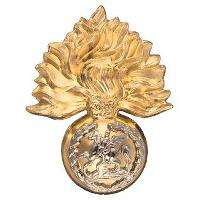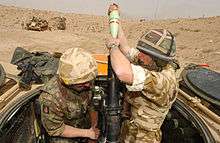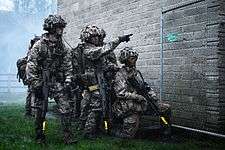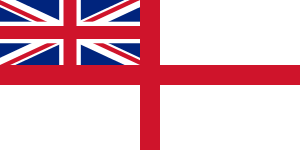Royal Regiment of Fusiliers
| The Royal Regiment of Fusiliers | |
|---|---|
 The Capbadge and Hackle of the Royal Regiment of Fusiliers | |
| Active | 23 April 1968 – Present |
| Allegiance |
|
| Branch |
|
| Type | Line Infantry |
| Role |
1st Battalion - Armoured Infantry 5th Battalion - Army Reserve |
| Size | Two Battalions |
| Part of | Queen's Division |
| Garrison/HQ |
|
| Nickname(s) |
The Fighting Fifth The Shiners The Old and the Bold Lord Wellington's Bodyguards |
| Motto(s) | "Honi soit qui mal y pense" (French) "Evil be to him who evil thinks" |
| March |
Quick - The British Grenadiers Slow - Rule Britannia |
| Mascot(s) |
Traditional - Black Buck - Bobby Substitute - Otterhound - George |
| Anniversaries |
St. George's Day (23 April) Gallipoli Day (25 April) Albuhera Day (16 May) Normandy Day (06 June) Minden Day (1 August) |
| Commanders | |
| Colonel in Chief | HRH The Duke of Kent, KG, GCMG, GCVO |
| Colonel of the Regiment | Major General PAE Nanson CBE |
| Insignia | |
| Tactical Recognition Flash |
 |
| Battalion Shoulder Title |
|
| Hackle | Red over White |
| Abbreviation | FUSILIERS |
The Royal Regiment of Fusiliers (FUSILIERS) is an Infantry Regiment of the British Army, part of the Queen's Division. Today it is a two Battalion Regiment with the Regular First Fusiliers operating as Armoured Infantry based in Tidworth, Wiltshire and the Reservist Fifth Fusiliers working across the North East of England. There are also a number of independent Reservist Fusilier sub-units based across England. Whilst the Fusiliers traditionally recruited in specific counties, today as an English regiment the Fusiliers recruit nationally. The Royal Regiment of Fusiliers was largely unaffected by the reforms of the Infantry that were announced in December 2004, but under the Army 2020 reduction in size of the Army its Second Battalion was merged into the First in 2014.
History Since 1968
The Regiment was formed on 23 April 1968 as part of the reforms of the British Army that saw the creation of 'large infantry regiments', by the amalgamation of the four English Fusilier regiments:[1]
- Royal Northumberland Fusiliers
- Royal Warwickshire Fusiliers
- Royal Fusiliers (City of London Regiment)
- Lancashire Fusiliers

The Royal Regiment of Fusiliers now recruits nationally but retains strong ties with its traditional counties of:

The 3rd Battalion of the Regiment saw active service in Iraq during the Gulf War in 1991.[2] All battalions have also been deployed to Northern Ireland on Operation Banner multiple times.[3]
In 2003 First Fusiliers Battlegroup were at the forefront of the Coalition Invasion of Iraq, ultimately occupying the City of Basra.[4] Over the next decade the Regiment carried out multiple operational tours of Iraq.[3]
In 2006 elements of the former Second Fusiliers were deployed to Afghanistan to support the International Security Assistance Force. Deployed to the town of Now Zad they rapidly found themselves fighting off a sustained Taliban attack that lasted for 107 days - the longest siege of British troops since World War II.[5] Over the following years elements of the Regiment deployed on several occasions to Afghanistan and saw heavy fighting.[6] Most recently the whole of First Fusiliers deployed to Nahri Saraj District, Afghanistan in 2013, where they took part in mounted and dismounted infantry operations.[7]
The Regiment received a reserve battalion, the 5th Battalion RRF, through the redesignation of Tyne-Tees Regiment, on 1 April 2006.[8]
In September 2014 the Second Fusiliers amalgamated with the First under Army 2020 ,forming just one regular battalion - an armoured infantry battalion under 1st Armoured Infantry Brigade.[9]

First Fusiliers
First Fusiliers are an Armoured Infantry Battalion based on Salisbury Plain in Tidworth Camp, Wiltshire. Equipped with the Warrior IFV, the Battalion is part of the Reactive Force of the Army and are held at high readiness as part of the Army's armoured war fighting reserve. In 2016 the First Fusiliers were the Army's Lead Armoured Battle Group, and were held at extreme high readiness in case they were required to deploy anywhere in the world at short notice. The Battalion is highly experienced with multiple deployments in the last two decades to Bosnia, Northern Ireland, Iraq and Afghanistan. Many Second Fusiliers soldiers with further experiences also joined the First Fusiliers on the merger, increasing the operational experience within their ranks. More recently the First Fusiliers have deployed around the world on exercise in places as diverse as Brunei, Kenya, the Baltic States and Canada.[10]
The First Fusiliers also regularly work in support of the civil powers in the UK. In 2013 large elements of the First Fusiliers were deployed to Wraysbury and the surrounding area to support the Flood Relief work.[11]
The First Fusiliers won the Army Boxing Championships in 2016, beating 2 PARA in the final.[12]
Fifth Fusiliers
The Fifth Fusiliers are a Reserve Battalion within the British Army centred on the North East of England. As a Battalion within the Adaptive Force, Fifth Fusiliers specialise in Light Role Infantry operations and have deployed all over the world on operations and on exercise both as a formed unit and as individual augmentees to the First Fusiliers.[13]
Fifth Fusiliers maintains subunits at the following locations:
- RHQ - Newcastle upon Tyne
- X Company - Newcastle upon Tyne and Hexham
- Z Company - Alnwick and Cramlington
- D Company - Durham, Bishop Auckland and Doncaster
- Recce Platoon ("Percy's Scouts") - Alnwick
- Fire Support (Machine Gun) Platoon - Hexham
- Mortar Platoon - Washington[13]
Fifth Fusiliers regularly work in partnership with First Fusiliers.[13]
Hackle
As a Fusilier regiment the Fusiliers wear a hackle - the red over white hackle of the Royal Northumberland Fusiliers. This distinction was originally a white plume which His Majesty's Fifth Regiment of Foot had taken from the head dress of fallen French troops at St. Lucia in December 1778. In 1829 King George IV ordered the white plume to be worn by all infantry regiments, and in order not to take away from the Fifth (Northumberland) Regiment of Foot's peculiar distinction and reflecting that they had won it in battle (according to legend the original plumes were stained red with the blood of their foes), their plume was differentiated by being made "half red and half white, the red uppermost, instead of the plain white feather worn by the rest of the army per the 1829 order, as a peculiar mark of honour."[14]
Victoria Crosses
The combined Victoria Crosses of the Fusiliers and its ancestor regiments total fifty five.[15] Of particular note are the first and last Victoria Crosses of the First World War - won by Lt Dease and Pte Godley at Mons in 1914 and Sgt Pearse in North Russia in 1919 - and the famous "Six VCs Before Breakfast" won at Gallipoli on 25 April 1915.[16]
Mascot
The regiment's traditional mascot is an Indian Blackbuck Antelope called Bobby, inherited from the Royal Warwickshire Fusiliers.[17] However Indian Blackbuck Antelopes are now protected under animal welfare rules and the Regiment has not been allowed one for several years. As a substitute the Regiment uses an Otterhound called George, who holds the rank of Fusilier and attends all the major parades which the Regiment is involved in.[18]
Roses
To mark certain Regimental Days the Fusiliers wear roses in their headdress and bedeck the Battalion Colours with garlands. The tradition comes from their victory at the Battle of Minden, where according to legend soldiers marched at dawn to battle through rose fields and so went into action with the roses adorning their headdress. On St Georges Day they wear red and white roses. On Minden Day they wear red and yellow roses. New Fusilier Officers also must eat a rose at their first Minden Dinner on joining the Regiment.[19]

The Colours
Within the British Infantry the Colours are traditionally viewed as the soul of a Battalion and are treated with an almost religious significance. The Standing Orders of the 1st Battalion, Royal Warwickshire Regiment in January 1883 declared that ‘The Officers carrying the Colours will consider themselves entrusted with the honour of the Regiment and defend them at every risk. The minds of the soldier must be impressed with the duty incumbent upon all to defend their Colours to the last extremity’. Unusually The Fusiliers carry a third colour to mark the Battle Honour of the Battle of Wilhelmsthal.[15]
The Queen’s Colour of each Battalion of the Regiment is identical except for the battalion numeral. The field is the Great Union bearing in the centre of St George's Cross the title of the Regiment in gold in a crimson circle, the battalion numeral in gold Roman within the circle, the whole ensigned with St Edward’s Crown. Forty Battle Honours, 20 in respect of the Great War and 20 in respect of the Second World War, are borne on scrolls in gold in three groups of six Honours on each horizontal arm of St George’s Cross and one group of four Honours on the lower vertical arm of the Cross. Honours are emblazoned in chronological order by theatres across the horizontal arm of the Cross and vertically on the lower arm of the Cross. The fringe is of crimson and gold alternate strands.[15]
The Regimental Colour of each Battalion of the Regiment is identical except for the battalion numeral. The field of this Colour is blue which is the same as the facing colour of the Regiment. The Regimental title is in gold in a crimson circle within a Union Wreath of roses, thistles and shamrocks. The Regimental title is in gold in a crimson circle within a Union Wreath of roses, thistles and shamrocks. St George within the Garter, which is the centre badge, is on a crimson ground within the circle. The whole is ensigned with St Edward’s Crown. Honorary distinction badges of our four former Regiments are borne in each canton of the Colour:[15]
- The Royal Northumberland Fusiliers - The United red and white rose slipped ensigned with the Royal Crest, in the upper canton nearer the pike.
- Royal Warwickshire Fusiliers - On a mount vert an Antelope statant argent, attired, tufted, ducally gorged and rope reflexed over the back, in the upper canton further from the pike.

- Royal Fusiliers - On a mount vert the White Horse of Hanover, in the lower canton nearer the pike.
- Lancashire Fusiliers - The red rose of Lancaster with two petals uppermost, in the lower canton further from the pike and The Sphinx, superscribed on a scroll ‘Egypt’, immediately below the tie of the large laurel wreath bearing the Battle Honour scrolls.
Finally thirty eight Battle Honours, which were borne on the Regimental Colours of the four former Regiments, are emblazoned on gold scrolls placed on the branches of a large laurel wreath outside the Union Wreath.[15]
 |
"The British Grenadiers"
"The British Grenadiers", the official Regimental Quick March of the Royal Regiment of Fusiliers, performed by the United States Army Band Strings ensemble |
| Problems playing this file? See media help. | |
The Drummer’s Colour (or Wilhelmstahl Colour) is of gosling green silk edged with gold, embroidered with St George and the Dragon in the centre, with red scrolls edged with gold, above and below. The motto of the Northumberland Fusiliers ‘QUO FATA VOCANT’ is, on the upper scroll, and the word ‘NORTHUMBERLAND’ between V REGT, also in gold, on the lower scroll. A wreath of green laurel with red berries and the ‘slipped’ red and white rose surmounted by a crown in the four corners, makes up the design. This unusual third colour is traditionally carried by the youngest drummer on the annual St George's Day parade.[15]
Lineage of the regiment
Battle honours
- Combined Battle Honours of The Royal Northumberland Fusiliers
- Combined Battle Honours of The Royal Warwickshire Fusiliers
- Combined Battle Honours of The Royal Fusiliers (City of London Regiment)
- Combined Battle Honours of The Lancashire Fusiliers
- Wadi al Batin, Gulf 1991,
- Al Basrah, Iraq 2003
Regimental Colonels
Regimental Colonels have been:[21]
- 1968–1974: Gen. Sir Kenneth Thomas Darling, GBE, KCB, DSO
- 1974–1977: Lt-Gen. Sir George Harris Lea, KCB, DSO, MBE
- 1977–1982: Lt-Gen. Sir Alexander James Wilson, KBE, MC
- 1982–1986: Maj-Gen. David Milner Woodford, CBE
- 1986–1996: Maj-Gen. Jeremy Calcott Reilly, DSO
- 1996–2001: Brig. David Arnold Kellett Biggart, OBE
- 2001–: Brig. Roy Maddox Wilde, CBE
- ?–2015: Brig. David J. Paterson, OBE
- 2015–: Maj-Gen. Paul Anthony Edward Nanson, CBE [22]
Order of Seniority Within the Line of Battle
| Preceded by Duke of Lancaster's Regiment |
Infantry Order of Precedence | Succeeded by Royal Anglian Regiment |
Alliances
 Royal Navy - HMS Diamond
Royal Navy - HMS Diamond Royal Navy - HMS Northumberland
Royal Navy - HMS Northumberland RAF - No. 13 Squadron RAF
RAF - No. 13 Squadron RAF Canada - The Royal Canadian Regiment
Canada - The Royal Canadian Regiment Canada - The Lorne Scots (Peel, Dufferin and Halton Regiment)
Canada - The Lorne Scots (Peel, Dufferin and Halton Regiment) Canada - 31 Combat Engineer Regiment (The Elgins)
Canada - 31 Combat Engineer Regiment (The Elgins) Canada - The Royal Westminster Regiment
Canada - The Royal Westminster Regiment Canada - Les Fusiliers du St-Laurent
Canada - Les Fusiliers du St-Laurent Australia - The Royal Victoria Regiment
Australia - The Royal Victoria Regiment New Zealand - The Hauraki Regiment
New Zealand - The Hauraki Regiment- The Worshipful Company of Mercers
- The Worshipful Company of Cordwainers
- The Worshipful Company of Fletchers
See also
![]() Media related to Royal Regiment of Fusiliers at Wikimedia Commons
Media related to Royal Regiment of Fusiliers at Wikimedia Commons
References
- ↑ Swinson, Arthur (1972). A Register of the Regiments and Corps of the British Army. London: The Archive Press. ISBN 0-85591-000-3.
- ↑ "Units in Operations Desert Shield and Desert Storm". Britain's small wars. Retrieved 26 April 2014.
- 1 2 "Royal Regiment of Fusiliers". British Army units 1945 on. Retrieved 30 April 2016.
- ↑ "Royal Regiment of Fusiliers in Basra, 22-23 April 2003". Imperial War Museum. Retrieved 26 April 2014.
- ↑ James Ferguson (2008). A Million Bullets - The True Story of the War in Afghanistan. Bantam Press. ISBN 978-0593059036.
- ↑ "Operation Veritas: British units deployed". Britain's small wars. Retrieved 26 April 2014.
- ↑ "Units to deploy as part of Herrick 18 announced". Ministry of Defence. 12 February 2013. Retrieved 2 August 2015.
- ↑ "Army engineers big change for Terriers". Evening Chronicle. 24 March 2006. Retrieved 26 April 2014.
- ↑ "Transforming the British Army: An Update" (PDF). Ministry of Defence. p. 7. Retrieved 30 April 2016.
- ↑ "1st Battalion - Armoured Infantry". Ministry of Defence. Retrieved 3 September 2016.
- ↑ "UK weather: Residents in Berkshire say military response is 24 hours too late". The Independent. 11 February 2015. Retrieved 3 September 2016.
- ↑ "Army Major Units Boxing Final 2016". Retrieved 3 September 2016.
- 1 2 3 "Fifth Fusiliers". Retrieved 3 September 2016.
- ↑ "Royal Regiment of Fusiliers: Regimental history". Ministry of Defence. Retrieved 26 April 2014.
- 1 2 3 4 5 6 "Regimental Handbook" (PDF). Regiments Direct. Retrieved 3 September 2016.
- ↑ "The six 'before breakfast' VCs reunited at last". The Daily Telegraph. Retrieved 4 Sep 2016.
- ↑ Ollington, Robin (2004). Bobby of the Fusiliers: The Story of Our Famous Regimental Mascot and Its Service and Adventures with Us for Over Two Hundred Years. Royal Regiment of Fusiliers. ISBN 9780954862909.
- ↑ "Meet Fusilier George". BFBS. Retrieved 5 Sep 2016.
- ↑ "In The Highest Tradition: The Royal Regiment of Fusiliers". BBC. Retrieved 4 Sep 2016.
- 1 2 The London Gazette, Page 3300-3301 (1 July 1881). "Childers Reform" (24992). Government of the United Kingdom. Retrieved 27 October 2016.
- ↑ "The Royal Regiment of Fusiliers". regiments.org. Retrieved 17 October 2016.
- ↑ https://www.thegazette.co.uk/London/issue/61372/supplement/18567/data.pdf
External links
- The Royal Regiment of Fusiliers
- The Fusiliers Facebook Page
- Fifth Fusiliers Facebook Page
- Royal Regiment of Fusiliers Regimental Shop
- The Royal Regiment of Fusiliers Regimental Handbook
- Fusiliers Association
- Fifth Foot reenactment group